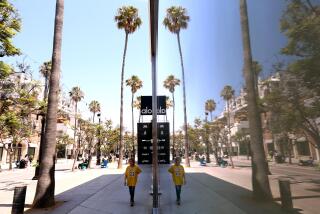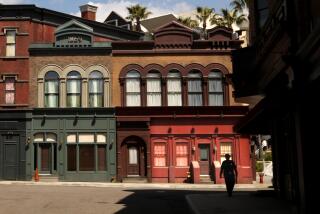Manhattan’s Financial District Remade by Influx of Residents
NEW YORK — When Tazz Latifi set out to open a pet supply store two years ago, she never thought she’d end up two blocks from the World Trade Center site.
“It was the last place I expected to be,” Latifi said. “It was the absolute last place I even looked at.”
What she found were reasonable rents in a surprisingly livable environment, one that is attracting more residents and small businesses.
“This area is really going to boom,” said Latifi, whose Petropolis store opened on Washington Street in February.
Wall Street, the historically gray financial district, is becoming more like a bustling, colorful Main Street. Once desolate at night, the area pulses with new vibrancy, increasingly resembling the rest of the city.
“I think I fell off my chair the first time I saw someone walking a dog on a Sunday morning,” said Alan Scott, head of corporate real estate at Deutsche Bank. “The financial district, especially this area around Wall Street, is becoming a 24/7 community.”
The transformation, though underway for years, was accelerated by the 2001 terrorist attacks on the World Trade Center, which forced some Wall Street stalwarts such as bond trader Cantor Fitzgerald and investment bank Lehman Bros. to find new office space. They chose Midtown Manhattan, which has long been the locale of choice for corporate headquarters, boasting the city’s finest restaurants, hotels and nightlife, as well as its signature office buildings and easier access to New York’s major rail depots and airports.
Their departures continued a decades-long decampment of leading Wall Street firms to Midtown.
Years ago, brokerages had to cluster on Wall Street so that “runners” could deliver stock certificates, but improved technology eliminated the need for physical proximity.
Today, many of the older buildings on Wall Street are ill-suited for the heavy wiring that securities-trading firms need. And big investment banks want football-field-sized trading floors that are available only in newer buildings.
Cantor, which lost 658 employees in the attacks, moved to 59th Street. Lehman bought a building from Morgan Stanley on 7th Avenue and 49th Street. Investment bank Keefe, Bruyette & Woods moved to 7th Avenue and 51st Street.
The companies say the moves were forced by necessity and should not be seen as an abandonment of Wall Street, which remains the symbol of global finance.
“Our building was severely damaged and unoperational,” Lehman spokeswoman Hannah Burns said. “It would have taken a year and a half to restore the building and its operations, and we could not wait that long.”
Even so, city officials worked hard to ensure that financial powerhouse Goldman Sachs Group would not join the exodus.
Goldman, whose headquarters was unaffected by 9/11, at one point considered going to Midtown because of dissatisfaction with long-stalled plans to redevelop the World Trade Center site, which have been mired in legal battles and political squabbling.
But $150 million in tax breaks and a redesign to alleviate worries about traffic and security helped persuade Goldman to build its new $2-billion headquarters across from the trade center site.
“We know downtown. It has been very good to us,” said Timur Galen, a Goldman managing director.
Along with Goldman, investment bank Merrill Lynch & Co., Deutsche Bank and American Express Co. continue to anchor downtown.
Now they’re being joined by thousands of new residents as well as a wave of upscale retailers and other businesses, in part because a citywide economic boom has sent residents and businesses on a pilgrimage for lower rents. Hedge funds, for example, are congregating in tony office buildings near Central Park, driving office space there to nearly $60 a square foot, according to real estate brokerage CB Richard Ellis.
Downtown is a relative bargain at about $36 a square foot.
The difference is reflected in the mix of tenants and businesses in the Wall Street area.
Companies accustomed to paying premium rents -- insurance companies, financial service firms and real estate outfits -- made up more than half the new tenants from 1998 to 2002, with each leasing more than 25,000 square feet, CB Richard Ellis said.
From 2003 to 2005, those companies accounted for just 40% of the new tenants for large leases.
The growth in residential use has been even more pronounced. In 1990, there were 13,675 people who called Lower Manhattan home, according to the real estate firm. That’s projected to reach 40,962 next year.
On virtually every block, construction crews are remaking old office buildings into apartments. Luxury condominiums are even rising across the street from the New York Stock Exchange.
“A lot of Wall Street itself is being converted to residential,” said Sheldon L. Cohen, who runs CB Richard Ellis’ downtown office.
High-end retailers are following suit, with Tiffany & Co., BMW and Whole Foods Market Inc. putting down stakes.
Unlikely as it would have seemed just a few years ago, downtown is becoming a destination spot of sorts for some New Yorkers.
Jim Falino is the chief technology officer of a software company based in the World Financial Center, the mammoth office complex across from the World Trade Center site.
But when he and his wife, Allison, who live in suburban Westchester County, took a Fourth of July weekend vacation with their children, they chose a nearby hotel.
“It’s surprising to see all the family-oriented life around here because you just think business,” Allison Falino said.
To some, the changes aren’t good news.
Wally Usiatynski, a musician and sound engineer who has lived on Chambers Street for 25 years, liked the area’s relative obscurity.
“I had a lot of friends who moved out because the character of the neighborhood changed,” he said.
Doreen Mogavero, a floor broker at the New York Stock Exchange, likes that buttoned-down Wall Street has loosened up.
But some changes, such as the ubiquitous presence of barricades and armed guards in the financial center, are reminders of the darkest day in New York’s history.
“It’s very bittersweet,” Mogavero said. “It’s great that we’re having a resurgence of people and activity in the area. But for the people here at the exchange you never forget the friends we lost that day or the horror of the whole thing.”
More to Read
Inside the business of entertainment
The Wide Shot brings you news, analysis and insights on everything from streaming wars to production — and what it all means for the future.
You may occasionally receive promotional content from the Los Angeles Times.










